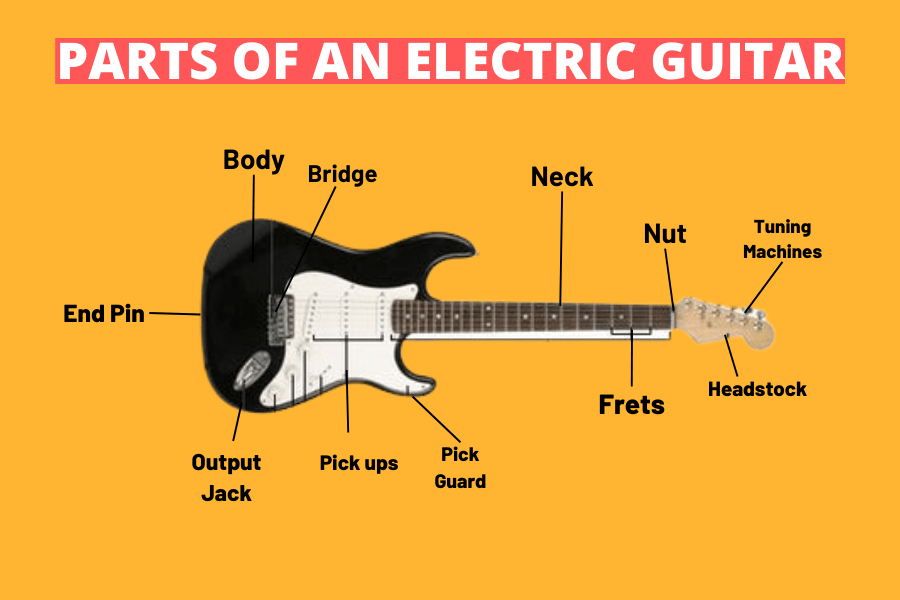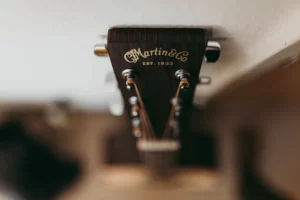Are you more into music and trying to interpret the sound notes? Firstly, you should know well about the instrument you have decided to pursue in this prolonged quest, and if that instrument is an electric guitar, we have your back.
Here is a detailed article about the Types of Electric Guitars and body styles to help you understand the different variations that an electric guitar might have.
Knowing the parts of an electric guitar before you start playing is essential. It will help you understand the instrument and how to care for it properly. So, if you’re new to learning the art of playing guitar, it’s helpful to understand the parts of a guitar first described below:
Key Parts of electric guitars
Headstock:
The headstock is the guitar part, where you will see your name and other information about your guitar, such as the model and serial numbers.
The headstock also contains several mounting points for accessories such as strap buttons and tuning keys. It comprises two sections: a neck plate, which has holes for attaching components, and a body, which houses all other components such as electronics, pickups, switches, and knobs.
The three types of the headstock are straight, angles, and scarf.
Body:
The guitar’s body is solid wood, although some manufacturers use laminated wood, allowing vibrations to pass through it.
The body is also used in the soundboard, which transfers the vibration from the strings to the air.
Body parts of the guitar are not just for aesthetic reasons but also because it houses most of the electronics and circuitry that allows an electric guitar to work.
The body of electric guitars comes in various shapes and sizes; however, the most common shapes are hollow-body guitars, semi-hollow body guitars, and solid-body guitars, respectively.
String:
The strings are tuned by a magnetic pickup that changes their pitch as they vibrate, causing them to produce sound and keep it tuned. Electric guitars need to be tuned at intervals for them to sound good. The strings can be attached to the body using either a set-in bridge (see below) or through-body stringing.
Neck:
The neck of the guitar is the part you hold when you play. It connects with the body through a bridge and sits on top of a headstock. The headstock connects it with other guitar parts, including tuning machines and electronics. It’s responsible for controlling how much pressure you apply when playing notes on the strings.
Strings:
These are what make the sound produced by an electric guitar come out. Strings are constructed with nickel or steel. They’re connected to the body and neck sections of a guitar with a bridge and tailpiece, respectively. Moreover, the strings must be tuned from lowest to highest note without mixing them up.
Fretboard:
Fretboard, also known as the fingerboard, is made of wood with frets that allow you to press down on them with your fingers. The strings are attached to these frets, which vibrate when you or another musician plays them. Different musical notes are played due to the vibrating motion of strings against the metal frets.
Frets:
The frets are the metal strips that make up the neck of the guitar. They provide a way to interact with different notes and chords using your fingers. There are typically twenty frets along each side of this fingerboard, which serve as places for fingers to rest while playing an instrument such as an electric guitar or acoustic guitar.
Fret markers:
The fret markers are small pieces of plastic that help you locate the specific string you want to play as well as help you keep track of which fret is playing at any given time. Fret markers are present on the 3rd, 5th, 7th, 9th, 12th, 15th, 17th, 19th, and 21st fret. It lets you see where your finger should go when playing those strings. Many electric guitars come standard with these to be easier for beginners and advanced players alike.
Saddle:
The saddle, a part of the bridge, sits on top of the fingerboard and supports the strings. It’s also the part that vibrates when you play your guitar. The strings are fastened to the saddle with a string nut or bridge. Saddles are made up of plastic or bone stuck to the bridge on acoustic guitars, while those on electric guitars are made of metal fixed to the fretboard with screws.
Bridge:
The bridge is one of the essential parts and lies at the bottom of an electric guitar. It helps transfer energy from the strings into your amp or amplifier via electromagnetic induction when you strum them. Without a bridge, there would be no way for anything but high-pitched squeaks to come out of your instrument’s speaker. It sits on top of the saddles and holds them in place at the bottom end of the instrument. It also forms a connection between the body and neck to vibrate together.
Machine Heads:
The machine heads are the movable components of the electric guitar. They are mounted on the instrument’s body and attached to the bridge, which is located above the strings. The machine heads can be adjusted to tune different strings and individual guitars properly. The machine heads on electric guitars are usually made of metal but can also be made of plastic.
Nut:
The nut is a small piece of metal that sits on top of the fretboard, usually on either side. It holds and stabilizes the string at its desired height above the fingerboard. The nut has holes through which strings pass when pulled away from their frets by fingers or picks so they can be plucked or strummed. The nut is crucial because it determines how much pressure you need on your strings to get a specific pitch.
Truss Adjustment rod:
The truss adjustment rod is a metal bar that runs through the neck of your guitar. It is located on the neck of the guitar, and it has a square-shaped bar that runs through it. It’s designed to keep the neck from twisting when you play certain chords and scales or when you bend strings. The truss rod is adjustable so that you can adjust its length to fit your playing style.
Pickguard:
The pickguard is a thin plastic plate that protects your guitar’s body and controls it from picking up dirt and dust. It also prevents your strings from coming in contact with the body of your guitar, which can make them go out of tune faster. You don’t need to clean your pickguard; wipe it off after playing or storing your guitar (but not too much). It also protects your fingers from getting injured by the strings while playing. It also protects against accidental contact with other parts of your guitar body or headstock,
Strap button:
A strap button is a metal plate with a hole that screws into the end of your guitar’s body. It’s used to attach a strap so you can carry your instrument around without slipping it out of your hand. The best position for the strap button is on the guitar’s heel, while the philosophy is to keep it in place with gravity.
Tremolo Bar:
A tremolo bar, also called a whammy bar, is a long metal pole attached to a bridge that stretches out of the guitar from one end while remaining fixed on the other. The function of the vibrato or Tremolo Bar is to change the pitch by raising or lowering notes.
How does the electric Guitar produce sound?
The sound of an electric guitar is created by the interaction between the strings and the pickups. A string vibrates at a particular frequency and causes a magnetic field to be induced around itself. It induces a current in the pickup coil, creating an electrical signal that can be electronically amplified. The electric guitar may also include an electronic circuit with an overdrive circuit to increase its distortion and sustain.
Difference between Electric and Acoustic Guitar:

The electric guitar is the most common type of guitar in use today. It has a hollow body with a sharp, pointed sound hole (also called an “f-hole”). The strings seem plucked with a plectrum or strummed with the fingers.
Electric guitars are often used in the country, blues, and rockabilly music styles. They’re also used in jazz and other genres and for accompaniment in folk music, rhythm and blues, and pop music.
Learn more about the different types of acoustic guitars to choose the best fit for your music
On the other hand, Acoustic guitars are similar to electric guitars but have an acoustic soundboard and flat wooden sound holes (these are round in electric guitars). You can play Acoustic guitars without an amplifier, but they’re generally amplified to produce their characteristic sound. They’re often played by themselves or with other instruments such as keyboards or drums.
Conclusion:
So, you didn’t know this about the guitar parts and what they do? Well, now you may probably have a better idea of an electric guitar and How to use it to win the hearts of people all ears to it. Similarly, the parts of an electric guitar are so easy to operate if you have a good knowledge and grip of its science.







